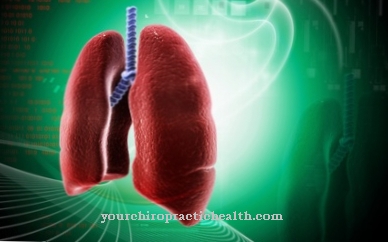As part of the Nucleic acid metabolism it is about the construction and breakdown of the nucleic acids DNA and RNA. Both molecules have the task of storing genetic information. Disturbances in the synthesis of DNA can lead to mutations and thus to changes in the genetic information.
What is nucleic acid metabolism?

The nucleic acid metabolism ensures the formation and breakdown of deoxyribonucleic acid (DNA) and ribonucleic acid (RNA). The DNA stores the entire genetic information in the cell nucleus for a long time. The RNA in turn is responsible for protein synthesis and thus transfers the genetic information to the proteins.
Both DNA and RNA consist of nucleobases, a sugar and a phosphate residue. The sugar molecule is connected to the phosphate residue via an esterification and binds to two phosphate residues. A chain of repeating phosphate-sugar compounds is formed, to which a nucleic base is glucosidically bound to the sugar.
In addition to phosphoric acid and sugar, five different nucleobases are available for the synthesis of DNA and RNA. The two nitrogen bases adenine and guanine belong to the purine derivatives and the two nitrogen bases cytosine and thymine belong to the pirimidine derivatives.
In the RNA, thymine has been exchanged for uracil, which is characterized by an additional CH3 group. The structural unit nitrogen base, sugar residue and phosphate residue is referred to as a nucleotide. In the DNA, a double helix structure is formed with two nucleic acid molecules, which are connected to one another by hydrogen bonds to form a double strand. The RNA consists of only one strand.
Function & task
The nucleic acid metabolism is of great importance for the storage and transmission of the genetic code. The genetic information is initially stored in the DNA through the sequence of nitrogen bases. The genetic information for an amino acid is encoded via three consecutive nucleotides. The successive base triplets store information about the structure of a certain protein chain. The beginning and end of the chain are set by signals that do not code for amino acids.
The possible combinations of nucleobases and the resulting amino acids are extremely large, so that with the exception of identical twins there are no genetically identical organisms.
In order to transfer the genetic information to the protein molecules to be synthesized, RNA molecules are first formed. The RNA acts as a transmitter of genetic information and stimulates the synthesis of proteins. The chemical difference between RNA and DNA is that instead of deoxyribose, the sugar ribose is bound in its molecule. Furthermore, the nitrogen base thymine has been exchanged for uracil.
The other sugar residue also causes the lower stability and the single-stranded nature of the RNA. The double strand in the DNA protects the genetic information against changes. Two nucleic acid molecules are connected to one another via hydrogen bonds. However, this is only possible with complementary nitrogen bases. In the DNA there can only be the base pairs adenine / thymine or guanine / cytosine.
When the double strand splits, the complementary strand is formed again and again. For example, if there is a change in a nucleic base, certain enzymes responsible for this during the repair of the DNA recognize which defect is present on the complementary base. The changed nitrogen base is usually correctly replaced. This is how the genetic code is secured. Sometimes an error can be passed on with the result of a mutation.
In addition to DNA and RNA, there are also important mononucleotides that play a major role in energy metabolism. These include, for example, ATP and ADP. ATP is adenosine triphosphate. It contains an adenine residue, ribose and the triphosphate residue. The molecule provides energy and when energy is released it is converted into adenosine diphosphate, whereby a phosphate residue is split off.
Illnesses & ailments
If disorders occur during nucleic acid metabolism, diseases can result. Errors can occur in the structure of the DNA, in which case the wrong nucleobase is used. Mutation occurs. Changes to the nitrogen bases can occur through chemical reactions such as deamination. Here, NH2 groups are replaced by O = groups.
Normally, the code is still stored in the DNA by the complementary strand, so that the repair mechanisms can fall back on the complementary nitrogen base when correcting the error. In the case of massive chemical and physical influences, however, so many defects can arise that an incorrect correction can sometimes be made.
Most of the time, these mutations take place in less relevant places in the genome, so that no effects are to be feared. However, if an error occurs in an important region, it can lead to a serious change in the genetic make-up with massive effects on health.
Somatic mutations are often the cause of malignant tumors. This is how cancer cells develop every day. As a rule, however, these are immediately destroyed by the immune system. However, if many mutations are formed through strong chemical or physical effects (e.g. radiation) or through a defective repair mechanism, cancer can develop. The same applies to a weakened immune system.
However, completely different diseases can also develop within the framework of nucleic acid metabolism. When the nucleic bases are broken down, the completely reusable beta-alanine is formed from pyrimidine bases. The poorly soluble uric acid is produced from purine bases. Humans have to excrete uric acid in the urine. If the enzymes to reuse the uric acid to build up purine bases are missing, the uric acid concentration can rise to such an extent that uric acid crystals precipitate in the joints and gout develops.



























